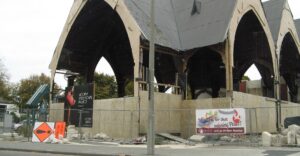
IIJA in Action: California’s Expanding Workforce
Pam Sornson, JD
May 21, 2024
Infrastructure development breeds employment, apparently. As a beneficiary of President Biden’s Infrastructure Investment and Jobs Act (IIJA), signed into law on November 15, 2021, California is receiving billions of dollars over a five- to ten-year period to revamp and improve its foundational infrastructure—its roads, energy systems, and natural resources. Additionally, and as a condition of accepting those funds for state-based infrastructure projects, recipient states must allocate a percentage of them to alleviate long-entrenched biases and inequities.
California is meeting the equity aspect of the deal by engaging and hiring thousands of small businesses to participate in completing IIJA projects. As a consequence of those investments (and as of September 25, 2023), more than 87,000 jobs have already been created in the State, and thousands more are on the books for development and deployment.

A ‘Just-in-Time’ Opportunity
The IIJA’s focus on job development couldn’t come at a better time for California. The State was hard hit by the coronavirus pandemic and has struggled to recover to its earlier, pre-COVID employment numbers. In March 2024, California had the highest unemployment rate in the country, at 5.3%. High unemployment rates have a significant and negative effect on their communities.
People without jobs generate a higher demand for public support and services.
Unemployed people are also less likely to shop, so their financial contribution to their community is reduced.
Long-term unemployment drains public coffers while eroding the quality of life for those who can’t find work. The IIJA and California’s strategy to improve its foundations (physical and social) will reduce the number of unemployed people and the negative impact that status has on the community.

Equity Identified
One unique type of entity that is singled out for enhanced IIJA attention is the ‘Disadvantaged Business Enterprise (DBE).’ Now championed by the Federal Department of Transportation (DoT), these usually smaller organizations have been battling the ongoing biases and discrimination often embedded in publicly funded transportation projects for years. To be considered a DBE, at least 51% of the company’s ownership must be held by ‘socially and economically disadvantaged individuals‘ who are also active in daily management and control efforts. Sadly, the DoT presumes that Hispanics, African Americans, Asian-Pacific and Subcontinent Asian Americans, Native Americans, and women are socially and economically disadvantaged, so businesses owned and run by members of those populations automatically qualify as DBEs. Companies without an automatic qualification must meet financial, size, and valuation standards to qualify for federal projects as a DBE. It is precisely these smaller, diverse entities that the IIJA intends to help by ensuring they have access to the same federal resources as their larger competitors that don’t face similar size or ethnicity challenges.
In addition to focusing on DBEs, the IIJA is also invested in improving the conditions in disadvantaged communities, those locales where residents struggle to maintain their health, have limited or no transportation options, and few meaningful employment opportunities. The federal funds will now enhance California’s Active Transportation Program (ATP), which expands transportation options to include those that provide health benefits, such as walking or bike riding. In many California locations, especially those in disadvantaged communities, there are no facilities for these types of transport, so building out that infrastructure is as critical to the project’s success as it is to get those residents moving.

Jobs Emerging with IIJA Funds
California’s vision for its IIJA allocation encompasses many new avenues of opportunity within foundational systems, so it’s a true boon for those seeking new work or a career in a new field. The word ‘infrastructure‘ itself encompasses virtually all the systems and services that facilitate a social organization’s functionality, and Newsom’s strategy attempts to inject resources across that full-service spectrum. The project expects to train and employ thousands of workers to achieve its goals, so many jobs are opening now, and many more will come over the next five to ten years.
Where Will Those Jobs Be?
A quick view of the allocation of IIJA dollars reveals precisely where the money will go in California and for what purpose. To assess and structure the deployment of the financial input, the federal government presumes that $1 billion invested funds 13,000 jobs, so reviewing the allocation strategy reveals the industries and sub-industries that will grow their workforce because of the IIJA:
Rebuilding the State’s transportation system is the most significant investment, and that overarching focus will generate thousands of jobs. Doing the math suggests that the $67.5 billion in road and bridge repairs alone would support a new workforce of over 870,000 employees.
Enhancing the transportation system is also in the works in the form of electric vehicles (EVs). While the IIJA anticipates a national network of EV charging stations, California can seek up to $3 billion to build out that system within its borders. Those funds would hire up to 39,000 workers.
The State is also considering another $100 million (1,300 jobs) to build out its broadband networks. The COVID pandemic revealed the challenges caused when people have no reliable form of communication; over half a million residents currently have no access to internet services. Additionally, the IIJA comes with an Affordability Connectivity Benefit that will reduce the cost of Internet access for over 10 million ‘modest means’ Californians.
Climate change is a central issue in the IIJA and California’s infrastructure strategy. Almost $140 million (1,800 jobs) will be spent on fire prevention, and another $3.5 billion (45,000 jobs) will fund weatherization projects across the State.
Clean water matters, too, and legacy lead pipes threaten the health of thousands of Californians. The IIJA provides $3.5 billion (45,000 jobs) to fund repairs and replacements to the water system’s infrastructure.
Air travel has evolved well beyond the capacity of many of California’s airports. With the IIJA’s $1.5 billion (19,000 jobs) contribution, many of the State’s air terminals will be updated and made safer.
The IIJA intends to rebuild and upgrade the nation’s infrastructure. California’s state-based investments combined with IIJA funds will have a decided impact on the safety and security of its infrastructure, and the workforce that grows as a result of that effort will have an equally significant impact on its economy. It’s a win-win-win all around.


